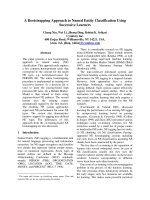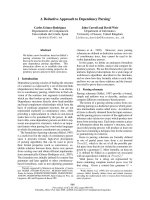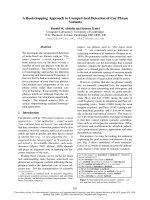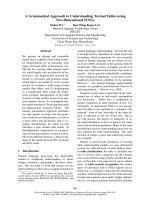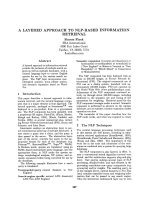Báo cáo khoa học: "A Uniform Approach to Underspecification and Parallelism" doc
Bạn đang xem bản rút gọn của tài liệu. Xem và tải ngay bản đầy đủ của tài liệu tại đây (629.42 KB, 8 trang )
A Uniform Approach to Underspecification and Parallelism
Joachim Niehren
Programming Systems Lab
Universitgt des Saarlandes
Saarbrficken, Germany
niehren©ps, uni- sb.
de
Manfred Pinkal
Department of
Computational Linguistics
UniversitS~t des Saarlandes
Saarbrficken, Germany
pinkal@coli, uni- sb.
de
Peter Ruhrberg
Department of
Computational Linguistics
Universit/it des Saarlandes
Saarbrficken, Germany
peru@coli, uni-sb,
de
Abstract
We propose a unified framework in which
to treat semantic underspecification and
parallelism phenomena in discourse. The
framework employs a constraint language
that can express equality and subtree rela-
tions between finite trees. In addition, our
constraint language can express the equal-
ity up-to relation over trees which cap-
tures parallelism between them. The con-
straints are solved by context unification.
We demonstrate the use of our framework
at the examples of quantifier scope, ellipsis,
and their interaction. 1
1 Introduction
Traditional model-theoretic semantics of natural
languages (Montague, 1974) has assumed that se-
mantic information, processed by composition and
reasoning processes, is available in a completely
specified form. During the last few years, the phe-
nomenon of semantic underspecification, i.e. the
incomplete availability of semantic information in
processing, has received increasing attention. Sev-
eral aspects of underspecification have been fo-
cussed upon, motivated mainly by computational
considerations: the ambiguity and openness of lex-
ical meaning (Pustejovsky, 1995; Copestake and
Briscoe, 1995), referential underspecification (Asher,
1993), structural semantic underspecification caused
by syntactic ambiguities (Egg and Lebeth, 1995),
and by the underdetermination of scope relations
(Alshawi and Crouch, 1992; Reyte, 1993). In ad-
dition, external factors such as insufficient coverage
1The research reported in this paper has been sup-
ported by the SFB 378 at the UniversitS.t des Saarlandes
and the Esprit Working Group CCL II (EP 22457).
of the grammar, time-constraints for parsing, and
most importantly the kind of incompleteness, uncer-
tainty, and inconsistency, coming with spoken input
are coming more into the focus of semantic process-
ing (Bos et al., 1996; Pinkal, 1995).
The aim of semantic underspecification is to pro-
duce compact representations of the set of possible
readings of a discourse. While the readings of a dis-
course may be only partially known, the interpre-
tations of its components are often strongly corre-
lated. In this paper, we are concerned with a uni-
form treatment of underspecification and of phenom-
ena of discourse-semantic parallelism. Some typical
parallelism phenomena are ellipsis, corrections, and
variations. We illustrate them here by some exam-
ples (focus-bearing phrases are underlined):
(1) John speaks Chinese. Bill too.
(2) John speaks Japanese. - No, he speaks
Chinese.
(3) ??? - Bill speaks Chinese, too.
Parallelism guides the interpretation process for the
above discourses. This is most obvious in the case of
ellipsis interpretation (1), but is also evident for the
resolution of the anaphor in the correction in (2),
and in the variation case (3) where the context is
unknown and has to be inferred.
The challenge is to integrate a treatment of paral-
lelism with underspecification, such as in cases of
the interaction of scope and ellipsis. Problematic
examples like (4) have been brought to attention by
(Hirschbuehler, 1982). The example demonstrated
that earlier treatments of ellipsis based on copying
of the content of constituents are insufficient for such
kinds of parallelism.
(4) Two European languages are spoken by many
linguists, and two Asian ones (are spoken by
many linguists), too.
410
The first clause of (4) is scope-ambiguous between
two readings. The second, elliptic one, is too. Its
interpretation is indicated by the part in parenthe-
ses. The parallelism imposed by ellipsis requires the
scope of the quantifiers in the elliptical clause to
be analogous to the scope of the quantifiers in the
antecedent clause. Thus, the conjunction of both
clauses has only two readings: Either the interpre-
tation is the wide scope existential one in both cases
(two specific European languages as well as two spe-
cific Asian languages are widely known among lin-
guists), or it is the narrow scope existential one
(many linguists speak two European languages, and
many linguists speak two Asian languages).
A natural approach for describing underspecified se-
mantic information is to use an appropriate con-
straint language. We use constraints interpreted
over finite trees. A tree itself represents a formula
of some semantic representation language. This ap-
proach is very flexible in allowing various choices
for the particular semantic representation language,
such as first-order logic, intensional logic (Dowty,
Wall, and Peters, 1981), or Discourse Representa-
tion Theory, DRT, (Kamp and Reyle, 1993). The
constraint approach contrasts with theories such as
Reyles UDRT (1993) which stresses the integration
of the levels of semantic representation language and
underspecified descriptions.
For a description language we propose the use of con-
text constraints over finite trees which have been in-
vestigated in (Niehren, Pinkal, and Ruhrberg, 1997).
This constraint language can express equality and
subtree relations between finite trees. More gen-
erally it can express the "equality up-to" relation
over trees, which captures (non-local) parallelism be-
tween trees. The general case of equality up-to con-
straints cannot be handled by a system using subtree
plus equality constraints only. The problem of solv-
ing context constraints is known as context unifica-
tion, which is a subcase of linear second-order unifi-
cation (L~vy, 1996; Pinkal, 1995). There is a com-
plete and correct semi-decision procedure for solving
context constraints.
Context unification allows to treat the interaction
of scope and ellipsis. Note that in example (4) the
trees representing the semantics of the source and
target clause must be equal up to the positions cor-
responding to the contrasting elements (two Euro-
pean languages / two Asian languages). Thus, this
is a case where the additional expressive power of
context constraints is crucial. In this paper, we elab-
orate on the example of scope and ellipsis interac-
tion. The framework appears to extend, however, to
all kinds of cases where structural underspecification
and discourse-semantic parallelism interact.
In Section 2, we will describe context unification,
and present some results about its formal proper-
ties and its relation to other formalisms. Section 3
demonstrates the application to scope underspeci-
fication, to ellipsis, and to the combined cases. In
Section 4, the proposed treatment is compared to re-
lated approaches in computational semantics. Sec-
tion 5 gives an outlook on future work.
2 Context Unification
Context unification is the problem of solving con-
text constraints over finite trees. The notion of con-
text unification stems from (L6vy, 1996) whereas
the problem originates from (Comon, 1992) and
(Schmidt-Schaul3, 1994). Context unification has
been formally defined and investigated by the au-
thors in (Niehren, Pinkal, and Ruhrberg, 1997).
Here, we select and summarize relevant results on
context unification from the latter.
Context unification subsumes string unification (see
(Baader and Siekmann, 1993) for an overview) and
is subsumed by linear second-order unification which
has been independently proposed by (L@vy, 1996)
and (Pinkal, 1995). The decidability of context uni-
fication is an open problem. String unification has
been proved decidable by (Makanin, 1977). The
decidability of linear second-order unification is an
open problem too whereas second-order unification
is known to be undecidable (Goldfarb, 1981).
The syntax and semantics of context constraints are
defined as follows. We assume an infinite set of first-
order variables ranged over by X, Y, Z, an infinite set
of second-order variables ranged over by C, and a
set of function symbols ranged over by f, that are
equipped with an arity n > 0. Nullary function
symbols are called constants. Context constraints
~o are defined by the following abstract syntax:
t
::= x I f(tl, ,t,) [ C(t)
~P ::: t:tl I ~A~ I
A (second-order) term t is either a first-order vari-
able X, a construction f(tl, , tn) where the arity
off is n, or an application C(t). A context constraint
is a conjunction of equations between second-order
terms.
Semantically, we interpret first-order variables X as
finite constructor trees, which are first-order terms
without variables, and second-order variables C as
context functions that we define next. A context with
411
and
Figure 1: The equality up-to relation
hole X
is a term t that does not contain any other
variable than X and has exactly one occurrence of
X. A conlezt function
7 is a function from trees
to trees such that there exists a variable X and a
context t with hole X satisfying the equation:
7(~r)
= t[~r/X]
for all trees or.
Note that context functions can be described by lin-
ear second-order lambda terms of the form
AX.t
where X occurs exactly once in the second-order
term t. Let a be a variable assignment that maps
first-order variables to finite trees and second-order
variables to context functions. The interpretation
(~(t) of a term t under a is the finite tree defined as
follows:
(~(a(tl, ,tn)) =
a(c~(tl), ,
~(tn))
=
A solution
of a context constraint ~ is a variable as-
signment a such that a(t) = a(t') for all equations
t = t' in 9. A context constraint is called
satisfi-
able
if it has a solution.
Context unification
is the
satisfiability problem of context constraints.
Context constraints (plus existential quantification)
can express subtree constraints over finite trees. A
subtree constraint has the form
X<<X'
and is inter-
preted with respect to the subtree relation on finite
trees. A subtree relation ¢r<<a ~ holds if cr is a subtree
of cr I, i.e. if there exists a context function 7 such
that a' = 7(a). Thus, the following equivalence is
valid over finite trees:
X<<X' ~ ~C(X' = C(X))
Context constraints are also more general than
equality up-to constraints over finite trees, which al-
low to describe parallel tree structures. An equality
up-to constraint has the form
X1/X~=Y1/Y~
and is
interpreted with respect to the equality up-to rela-
tion on finite trees. Given finite trees al,cr~, cr2,a~,
the equality up-to relation
ai/a~=a2/a~
holds if ~r~
is equal to ~2 up-to one position p where al has the
subtree a~ and ~2 the subtree a S. This is depicted in
Figure 1. In this case, there exists a context function
7 such that al = 7(al) and a2 = 7(a~). In other
words, the following equivalence holds:
X/X'=Y/Y' +-+ 3C(X=C(X') AY=C(Y'))
Indeed, the satisfiability problems of context con-
straints and equality up-to constraints over finite
trees are equivalent. In other words, context uni-
fication can be considered as the problem of solving
equality up-to constraints over finite trees.
2.1 Solving Context Constraints
There exists a correct and complete semi-decision
procedure for context unification. This algorithm
computes a representation of all solutions of a con-
text constraint, in case there are any. We illustrate
the algorithm in figure 2. There, we consider the
constraint
X,=@(Q(s, c), j) A X, =C(Xcs) A
Xc,=j
which is also discussed in example (11)(i) as part of
an elliptical construction.
Our algorithm proceeds on pairs consisting of a con-
straint and a set of variable bindings. At the begin-
ning the set of variable bindings is empty. In case
of termination with an empty constraint, the set of
variable bindings describes a set of solutions of the
initial constraint.
Consider the run of our algorithm in figure 2. In the
first step, Xs =@(@(s, c), j) is removed from the con-
straint and the variable binding X8 ~-* @(@(s, c), j)
is added. This variable binding is applied to the
remaining constraint where X8 is substituted by
@(@(s, c), j). The second computation step is simi-
lar. It replace the to constraint
Xcs=j
by a variable
binding Xcs ~-~ j and eliminates
Xc8
in the remain-
ing constraint.
The resulting constraint
@(@(s,c),j) = C(j)
presents an equation between a term with a con-
stant @ as its ("rigid") head symbol and a term with
a context variable C as its ("flexible") head sym-
bol. In such a case one can either apply a projection
rule that binds C to the identity context
AY.Y
or an
412
false
Xs=@(@(s,c),j) A Xs=C(Xc,) A Xc,=j
l x, @(@(=, c),
J)
@(@(s,c),j)=C(X~) A Xc==j
~ Xc, ~ j
@(@(s, c),
j)=C(j)
c
c),
@(s,
c)=C'(j) j=C'(j)
1
false j=j
1
true
Figure 2: Solving the context constraints of example (ll)(i)
imitation rule. Projection produces a clash of two
rigid head symbols @ and j. Imitation presents two
possibilities for locating the argument j of the con-
text variable C as a subtree of the two arguments
of the rigid head symbol @. Both alternatives lead
to new rigid-flexible situations. The first alternative
leads to failure (via further projection or imitation)
as @(s, c) does not contain j as a subtree. The sec-
ond leads to success by another projection step.
The unique solution of the constraint in figure 2 can
be described as follows:
Xs ~-* @(@(8, c), j),
Xc= ~ j,
c AY.@(@(=, c), Y)
The full version of (Niehren, Pinkal, and Ruhrberg,
1997) contains discussions of two algorithms for con-
text unification. For a discussion on decidable frag-
ments of context constraints, we also refer to this
paper.
3 Underspecification and Parallelism
In this section, we discuss the use of context unifica-
tion for treating underspecification and parallelism
by some concrete examples. The set of solutions of
a context constraint represents the set of possible
readings of a given discourse. The trees assigned by
the solutions represent expressions of some seman-
tic representation language. Here, we choose (ex-
tensional) typed higher-order logic, HOL, (Dowty,
Wall, and Peters, 1981). However, any other logical
language can be used in principle, so long as we can
represent its syntax in terms of finite trees.
It is important to keep our semantic representation
language (HOL) clearly separate from our descrip-
tion language (context constraints over finite trees).
We assume an infinite set of HOL-variables ranged
over by x and y. The signature of context constraints
contains a unary function symbol
lamx
and a con-
stant var. per HOL-variable x. Futhermore, we as-
sume a binary function symbol @ that we write in
left associative infix notation and constants like john,
language, etc. For example the tree
(many@language)@(lamx((spoken_by@john)@varx))
represents the HOL formula
(=poke by(j
Note that the function symbol @ represents the ap-
plication in HOL and the function symbols lamx the
abstraction over x in HOL.
413
3.1 Scope
Scope underspecification for a sentence like (5) is
expressed by the equations in (6):
(5)
(6)
Two languages are spoken by many linguists.
Xs = Cl((two@language)@lamx(C3(X~s))) A
Xs = C2((many@linguist)@lamy(C4(X~s))) A
X~ =
spoken_by@vary@var~
The algorithm for context unification leads to a dis-
junction of two solved constraints given in (7) (i)
and (ii).
(7)
(i) Xs =
O1 ((twoQlanguage)@la mx (
Cs((many@linguist)@lamy(
C4(spoke._by@var,@var )))))
(ii) Xs
=
C2 ((many@linguist)@lam,(
C6 ((two@language)@lam~(
C3 (spoken_by@var,@varx)))))
The algorithm does in fact compute a third kind of
solved constraint for (6), where none of the quan-
tifiers two@language and many@linguist are required
to be within the scope of each other. This possibility
can be excluded within the given framework by us-
ing a stronger set of equations between second-order
terms as in (6'). Such equations can be reduced to
context constraints via Skolemisation.
(6') Cs = )~X.Cl(two@language@lamx(C3(X))) A
Cs = AX.Cz(many@linguist@lamy(C4(X))) A
Xs
= Cs(spoken_by@vary@varx)
Both solved constraints in (7) describe infinite sets of
solutions which arise from freely instantiating the re-
maining context variables by arbitrary contexts. We
need to apply a closure operation consisting in pro-
jecting the remaining free context variables to the
indentity context AX.X. This gives us in some sense
the minimal solutions to the original constraint. It
is clear that performing the closure operation must
be based on the information that the semantic ma-
terial assembled so far is complete. Phenomena of
incomplete input, or coercion, require a withholding,
or at least a delaying of the closure operation. The
closure operation on (7) (i) and (ii)leads to the two
possible scope readings of (5) given in (8) (i) and
(ii) respectively.
(8)
(i) Xs
(two@language)@lamx(
(many@linguist)@lamy(
spoken_by@vary@vary))
(ii) Xs
(many@linguist)@lamy(
(two@language)@lamx(
spoken_by@vary@varx))
A constraint set specifying the scope-neutral mean-
ing information as in (6') can be obtained in a rather
simple compositional fashion. Let each node P in
the syntactic structure be associated with three se-
mantic meta-variables Xp, X~p, and Cp, and let
I(P) be the scope boundary for each node P . Rules
for obtaining semantic constraints from binary syn-
tax trees are:
(9)
(i) For every S-node P add Xp = Cp(X~p),
for any other node add Xp = X~p.
(ii) If[p V R], Q and Rare not NP nodes,
add X~ = XQ@Xn or X~p = XI~@XQ,
according to HOL type.
(iii) If [p Q R] or [p R Q], and R is an
NP node, then add X~o = XQ@varx and
c,(p) = :,X.Co(X,@lam.(Cl(X))).
For example, the first two constraints in example (6')
result from applying rule (iii), where the values for
the quantifiers two@language and many@linguist are
already substituted in for the variables XR in both
cases. The quantifiers themselves are put together
by rule (ii). The third constraint results from rule
(i) when the semantics of X~ is filled in. The latter
is a byproduct of the applications of rule (iii) to the
two NPs.
3.2 Ellipsis
We now look into the interpretation of examples (1)
to (4), which exhibit forms of parallelism. Let us
take Xs and Xt to represent the semantics of the
source and the target clause (i.e., the first and the
second clause of a parallel construction; the termi-
nology is taken over from the ellipsis literature), and
Xcs
and Xct to refer to the semantic values of the
contrast pair. The constraint set of the whole con-
struction is the union of the constraint sets obtained
by interpreting source and target clause independent
of each other plus the pair of constraints given in
(10).
(lo) x, = c(xo=) ^ x, = c(xc,)
414
The equations in (10) determine that the semantics
of the source clause and the semantics of the tar-
get clause are obtained by embedding the represen-
tations of the respective contrasting elements into
the same context. In other words: Source semantics
and target semantics must be identical up to the
positions of the contrasting elements.
As an example, consider the ellipsis construction of
Sentence (1), where for simplicity we assume that
proper names are interpreted by constants and not
as quantifiers. It makes no difference for our treat-
ment of parallelism.
(11)
(i)
X~ = speak@chinese@john
A
Xc,
=
john A
Xs =
C(Xcs)
(ii) Xa = bill
A Xt = C(Xot)
By applying the algorithm for context unification to
this constraint, in particular to part (i) as demon-
strated in figure 2, we can compute the context C
to be AY.(speak@chinese@Y). This yields the inter-
pretation of the elliptical clause, which is given by
Xt ~
speak@chinese@bill.
Note that the treatment of parallelism refers to con-
trasted and non-contrasted portions of the clause
pairs rather than to overt and phonetically unreal-
ized elements. Thus it is not specifc for the treat-
ment of ellipsis, but can be applied to other kinds
of parallel constructions, as well. In the correction
pair of Sentence (2), it provides a certain unam-
biguous reading for the pronoun, in (3), it gives
X8 =
speak@chinese@X~ as
a partial description
of the (overheard or unuttered) source clause.
3.3 Scope and Ellipsis
Finally, let us look at the problem case of par-
allelism constraints for structurally underspecified
clause pairs. We get a combination of constraints for
a scope underspecified source clause (12) and paral-
lelism constraints between source and target (13).
(12) Cs =
AX.Ol((two@e_language)@lam,(C3(X)))
A
C~ = AX.C2( ( rnany@linguist )@lamy( C4( X ) ) )
A
Xs = Cs(spoken_by@vary@varx)
(13) X, =
C(two@e_language) A
Xt C(two@a_language)
The conjunction of the constraints in (12) and (13)
correctly allows for the two solutions (14) and (15),
with corresponding scopings in Xs and
Xt
after
closure. 2
(14) X~
(two@e_language)@lamx (
(ma ny@linguist)Qla rny (
spoken_by@vary@varx)) A
X t
(two@a_la nguage)@la m~(
(ma ny@linguist)@lamy (
spoken_by@vary@varx)) A
AY.
Y
@lamx(
(many@linguist)Qlamy(
spoken_by@vary@varx))
(15) Xs ~-*
(many@linguist)@lamy(
(two@e_language)Qlarnx(
spoken_by@vary@vary)) A
i t
(many@linguist)@lamy(
(two@a_language)@la rnx(
spoken_by@varyQvarx)) A
el +
AY. (manyQlinguist)Qlamy(
Y
@lamx(
spoken_by@vary@varx))
Mixed solutions, where the two quantifiers take dif-
ferent relative scope in the source and target clause
are not permitted by our constraints. For example,
(16) provides no solution to the above constraints.
(16)
X 3
(twoQe_language)@lam~ (
(many@linguist)Qlamy(
spoken_by@vary@varx))
Xt t 4.
(rna ny@linguist)@la my (
(two@a_language)@lamx(
spoken_by@varyQvarx))
2Notice that closure is applied to the solved form of
the combined constraints (i.e. (14) and (15) respectively)
of the two sentences here, rather than to solved forms of
(12) and (13) separately. This reflects the dependency
of the interpretation of the second sentence on material
in the first one.
415
From the trees in (16) one cannot construct a con-
text function to be assigned to C which solves the
parallelism constraints in (13).
4 Comparison to other Theories
Standard theories for scope underspecification make
use of subtree relations and equality relations only.
Such relationships may be expressed on a level of a
separate constraint language, as in our case, or be in-
corporated into the semantic formalism itself, as it is
done for DRT by the system of UDRT (Reyle, 1993).
In UDRT one introduces "labels" that behave very
much like variables for DRSes. These labels figure
in equations as well as subordination constraints to
express scope relations between quantifiers. Equa-
tions and subordination constraints alone do not
provide us with a treatment of parallelism. An idea
that seems to come close to our notion of equal-
ity up-to constraints is the co-indexing technique in
(Reyle, 1995), where non-local forms of parallelism
are treated by dependency marking on labels. We
believe that our use of a separate constraint language
is more transparent.
A treatment for ellipsis interpretation which uses a
form of higher-order unification has been proposed
in (Dalrymple, Shieber, and Pereira, 1991) and ex-
tended to other kinds of parallel constructions by
(Gardent, Kohlhase, and van Leusen, 1996; Gardent
and Kohlhase, 1996). Though related in some re-
spects, there are formal differences and differences in
coverage between this approach and the one we pro-
pose. They use an algorithm for higher-order match-
ing rather than context unification and they do not
distinguish an object and meta language level. As
a consequence they need to resort to additional ma-
chinery for the treatment of scope relations, such
as Pereira's scoping calculus, described in (Shieber,
Pereira, and Dalrymple, 1996).
On the other hand, their approach treats a large
number of problems of the interaction of anaphora
and ellipsis, especially strict/sloppy ambiguities.
Our use of context unification does not allow us to
adopt their strategy of capturing such ambiguities
by admitting non-linear solutions to parallelism con-
straints.
5 Outlook
Extensions of context unification may be useful for
our applications. For gapping constructions, con-
texts with multiple holes need to be considered. The
algorithm for context unification described in the
complete version of (Niehren, Pinkal, and Ruhrberg,
1997) makes use of contexts with multiple holes in
any case.
So far our treatment of ellipsis does not capture
strict-sloppy ambiguities if that ambiguity is not
postulated for the source clause of the ellipsis con-
struction. We believe that the ambiguity can be
integrated into the framework of context unifica-
tion without making such a problematic assump-
tion. This requires modifying the parallelism re-
quirements in an appropriate way. We hope that
while sticking to linear solutions only, one may be
able to introduce such ambiguities in a very con-
trolled way, thus avoiding the overgeneration prob-
lems that come from freely abstracting multiple vari-
able occurrences. This work is currently in progress,
and a deeper comparison between the approaches
has yet to be carried out.
An implementation of a semi-decision procedure for
context unification has been carried out by Jordi
L6vy, and we applied it successfully to some sim-
ple ellipsis examples. Further experimentation is
needed. Hopefully there are decidable fragments of
the context unification problem that are empirically
adequate for the phenomena we wish to model.
References
Alshawi, H. and D. Crouch. 1992. Monotonic se-
mantic interpretation. In 30th Annual Meeting of
the Association of Computational Linguistics, pages
32-38.
Asher, Nick. 1993. Reference to abstract objects in
discourse. Kluwer, Dordrecht.
Bander, F. and J. Siekmann. 1993. Unification the-
ory. In D. Gabbay, C.J. Hogger, and J.A. Robinson,
editors, Handbook of Logic in Artificial Intelligence
and Logic Programming. Oxford University Press.
Bos, Johan, Bj6rn Gambi~ck, Christian Lieske,
Yoshiki Mori, Manfred Pinkal, and Karsten Worm.
1996. Compositional semantics in Verbmobil. In
Proceedings of the 16th International Conference on
Computational Linguistics, volume 1, pages 131-
136, Ktbenhavn, Denmark, August. ACL.
Comon, ttubert. 1992. Completion of rewrite sys-
tems with membership constraints. In W. Kuich, ed-
itor, Proc. 19th Int. Coll. on Automata, Languages
and Programming, LNCS 623, Vienna. Springer-
Verlag.
Copestake, A. and E. J. Briscoe. 1995. Semi pro-
ductive polysemy and sense extension. Journal of
Semantics, 12:15-67.
416
Dalrymple, Maryl Stuart Shieber, and Fernando
Pereira. 1991. Ellipsis and higher order unification.
Linguistics and Philosophy, 14:399-452.
Dowty, D., R. Wall, and S. Peters. 1981. Introduc-
tion to Montague semantics. Reidel, Dordrecht.
Egg, M. and K. Lebeth. 1995. Semantic un-
derspecification and modifier attachment ambigui-
ties. In J. Kilbury and R. Wiese, editors, Inte-
grative Ansaetze in der Computerlinguistik. Duessel-
doff, pages 19-24.
Gardent, Cl~.ire and Michael Kohlhase. 1996. Fo-
cus and higher-order unification. In Proceedings of
COLING-96, Copenhagen.
Gardent, Claire, Michael Kohlhase, and Noor van
Leusen. 1996. Corrections and Higher-Order
Unification. In Proceedings of KONVENS-96. De
Gruyter, Bielefeld, Germany, pages 268-279.
Goldfarb, W. D. 1981. The undecidability of the
second-order unification problem. Theoretical Com-
puter Science, 13:225-230.
Hirschbuehler, Paul. 1982. Vp deletion and across
the board quantifier scope. In J. Pustejovsky and
P. Sells, editors, NELS 12, University of Massachus-
setts, Amherst.
Kamp, H. and U. Reyle. 1993. From Discourse to
Logic. Kluwer, Dordrecht.
L~vy, Jordi. 1996. Linear second order unification.
In Proceedings of the Conference on Rewriting Tech-
niques and Applications. Springer-Verlag.
Makanin, G.S. 1977. The problem of solvability of
equations in a free semigroup. Soviet Akad. Nauk
SSSR, 223(2).
Montague, R. 1974. The proper treatment of quan-
tification in ordinary english. In R. Thomason, ed-
itor, Formal Philosophy. Selected Papers of Richard
Montague. Yale University Press, New Haven and
London, pages 247-271.
Niehren, Joachim, Manfred Pinkal, and Peter
Ruhrberg. 1997. On equality up-to constraints over
finite trees, context unification and one-step rewrit-
ing. In Proceedings of the l~th International Confer-
ence on Automated Deduction. A complete verison is
available from
In Press.
Pinkal, Manfred. 1995. Radical underspecification.
In Paul Dekker and Martin Stokhof, editors, Pro-
ceedings of the lOth Amsterdam Colloquium, Uni-
versity of Amsterdam.
Pustejovsky, J. 1995. The Generative Lexicon. MIT
press, Mambridge MA.
Reyle, Uwe. 1993. Dealing with ambiguities by un-
derspecification: construction, representation, and
deduction. Journal of Semantics, 10:123-179.
Reyle, Uwe. 1995. Co-indexing labelled DRSs to
represent and reason with ambiguities. In S. Pe-
ters and K. van Deemter, editors, Semantic Am-
biguity and Underspecification. CSLI Publications,
Stanford.
Schmidt-SchaufS, Manfred. 1994. Unification of
stratified second-order terms. Technical Report
internal report 12/94, J. W. Goethe Universit~it,
Frankfurt, Germany.
Shieber, Stuart, Fernando Pereira, and Mary Dal-
rymple. 1996. Interactions of scope and ellipsis.
Linguistics and Philosophy, 19:527-552.
41 7
